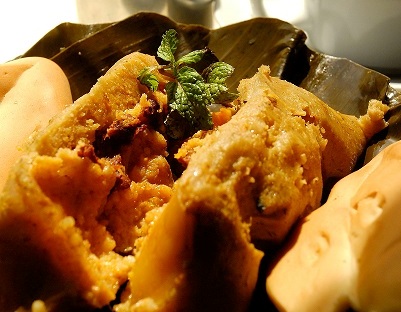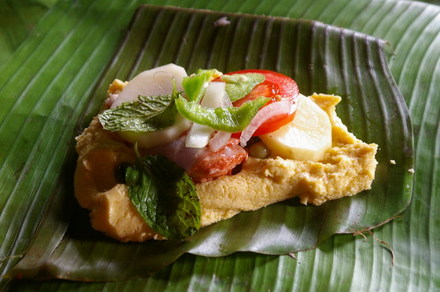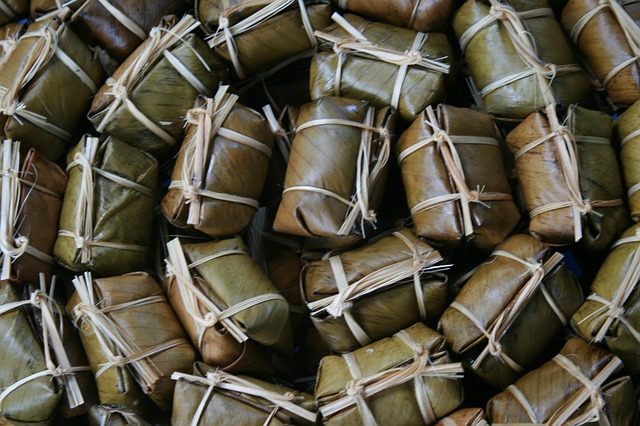IN this series, we will be hearing from contributors all over the world about dishes that are important to them. This article is from Malva Izquierdo, from Nicaragua, who shares a recipe for a traditional dish. If you’re interested in contributing your favourite dish or meal, contact Sarah at sarah@studentworldonline.com.

The nacatamal is one of the most traditional Nicaraguan meal and it is an event often reserved for Sundays at mid-morning with family and friends, it is usually eaten together with fresh bread and coffee.
The key for a good nacatamal is the nixtamalized corn masa (a kind of dough traditionally made from a process called nizquezar) and lard, it also includes seasonings such as salt and achiote (annatto) that boost the flavour.
You will need plantain leaves to wrap the masa into large individual portions, but before that you must prepare the filling. This usualy consists of rice, annatto-seasoned pork meat, potatoes, meat and vegetables but the exact ingredients vary from family the family. You can for instance substitute or complement the pork with pieces of chicken, add more spices and peppers, or include Mediterranean imports like raisins, capers, garlic and olives.
The masa and filling are then wrapped in the plantain leaves, tied with a string, and made into pillow-shaped bundles - nacatamales. They are then steamed or pressure-cooked for several hours. The entire process is traditionally cooked in a large batch over a wood fire and it is very labor-intensive and it often requires preparation over the course of two days.

As this is a meal that you need to enjoy with your family and friends (loneliness and nacatamals don't go good together) here is the recipe for you to make a dozen nacatamals:
Dough ingredients
6 cups of masa de harina (a type of corn flour).
1 cup of lard or shortening.
1 tablespoon of salt.
4-5 cups of chicken stock or broth.
½ cup of sour orange juice (English name for 'naranja agria', the fruit is also known as sour orange, bitter orange, bigarade orange, if you can't find it, just mix 4 parts lime juice, 2 parts orange juice, 2 parts lemon juice, and a pinch of lemon rind).
How to make the dough
Mix masa de harina, lard/shortening, and salt together in a bowl. The easiest way of doing this is to use an electric mixer, but the traditional way is of course to do it by hand. It is important to fully incorporate the fat into the flour; the end result should have a mealy texture. For the novice, doing two or three small batches may be easier than trying to do the entire batch at once.
Mix in the sour orange juice and enough chicken stock or broth to make a soft, moist dough. It should just be a tad firmer than mashed potatoes. Knead for several minutes to make the dough fluffier.
Cover the bowl and leave to rest for at least half an hour.
Filling ingredients
¾ cup of rice.
3 pounds of pork butt.
Salt and pepper.
½ pound of potato.
1 onion.
2 sweet peppers.
2 tomatoes.
1 bunch of mint (to taste).
How to make the filling
Soak the rice in warm water for half an hour.
Cube the pork butt and season it with salt and pepper.
Peel and slice the potatoes and onion into ¼ inch rounds.
Slice the sweet peppers and tomatoes into ¼ inch rounds.
Drain the rice.
What you need to assemble a nacatamal
1 banana leaf for each nacatamal (you can find banana leaves in special Indian markets or in Amazon). 1 piece of 10×10 inch aluminium foil for each nacatamal.

How to assemble nacatamals
Remove the hard spine from the banana leaves and cut the leaves into 10×10 inch rectangles.
Lay out a banana leaf with the smooth side up.
Place one cup of dough in the centre of the leaf, wet your hands, and spread out the dough.
Placeroughly ½ cup of pork on top of the dough.
Sprinkle 1-2 tablespoons of rice over the pork, add 1-2 slices of potato and finish off with 1-2 pieces of onion, 1-2 pieces of pepper, and a slice of tomato. Place a few mint leaves on top.
Carefully fold the top edge of the leaf down over the filling and bring the bottom edge up over the top to make a sort of envelope. Fold both sides in and you’ll have a small rectangular package. If you warp too tightly, the filling will squeeze its way out when thenacatamal is steamed.
Place thenacatamal with the seam side down on a piece of aluminium foil and wrap it up tightly, just like you did with the banana leaf.
Before the advent of aluminium foil, nacatamales were just tied together with strings, if this is your first time preparing this meal you should start out with aluminium foil.
You’ll need a large pot or several small ones. Nacatamales take up quite a lot of space and you need to steam them for 3-4 hours so having to do one batch after another because your pot is too small will be rather time consuming, even by Nicaraguan standards.
How to steam nacatamales
If you don’t have a tamale steamer with steam slats, place a rack over the bottom of your pot or toss in wadded pieces of aluminium. The important thing is to hold the nacatamales mostly out of the water.
Add 2-3 inches of water to the pot.
Place thenacatamales in the pot and bring to a boil over high heat.
Put on atight fitting lid, turn down the heat and leave the nacatamales to be steamed for 3-4 hours. Check the pot regularly and, if necessary, add more water to keep it from boiling dry.
When the nacatamales are ready, take off the aluminium wrapping and serve them right away. They should be served with the banana leaf unopened; each dinner guest opens his or her banana leaf on her own. And no, you’re NOT supposed to eat the banana leaf!!!